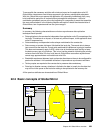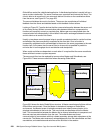
Chapter 22. Global Mirror overview 261
Figure 22-16 Formation of consistent set of volumes at the secondary site
Note that before step 1 and after step 3, Global Copy constantly scans through the
out-of-sync bitmaps and replicates data from A volumes to B volumes as described in “Create
Global Copy relationship between local and remote volume” on page 256.
When the creation of Consistency Group is triggered, the following steps occur in a serial
fashion:
1. Serialize all Global Copy primary volumes. This imposes a brief hold on all incoming write
I/Os to all involved Global Copy primary volumes. Once all primary volumes are serialized,
the pause on the incoming write I/O is released and all further write I/Os are now noted in
the change recording bitmap. They are not replicated until step 3 is done, but application
write I/Os can immediately continue.
2. Drain includes the process to replicate all remaining data that is indicated in the
out-of-sync bitmap and still not replicated. Once all out-of-sync bitmaps are
empty—note
that “empty” here does not mean in a literal sense—step 3 is triggered by the microcode
from the primary site.
3. Now the B volumes contain all data as a quasi point-in-time copy, and are consistent due
to the serialization process in step 1 and the completed replication or drain process in step
2. Step 3 is now a FlashCopy that is triggered by the primary system’s microcode as an
inband FlashCopy command to volume B, as FlashCopy source, and volume C, as
FlashCopy target volume. Note that this FlashCopy is a two phase process. First, the
FlashCopy command to all involved FlashCopy pairs in the Global Mirror session. Then
the Master collects the feedback and all incoming FlashCopy completion messages.
When all FlashCopy operations are successfully completed, then the Master concludes
that a new Consistency Group has been successfully created.
FlashCopy applies here only to changed data since the last FlashCopy operation. This is
because the
start change recording property was set at the time when the FlashCopy
relationship was established. The FlashCopy relationship does not end due to the
nocopy
property, which is also assigned at FlashCopy establish time; see “Introduce FlashCopy”
on page 257. Note that the
nocopy attribute results in that no physical background copy is
done for any tracks. Only bitmaps are maintained and updated.
2
Local
Serialize all
Global Copy
primary volumes
Drain data from local to remote site
Perform
FlashCopy
Primary
A2
Primary
A1
B2
Secondary
B1
Secondary
C2
Tertiary
C1
Tertiary
Start
Done
Start
Done
Start
Done
Remote
1
3
O
O
S
O
O
S
C
R
C
R


















